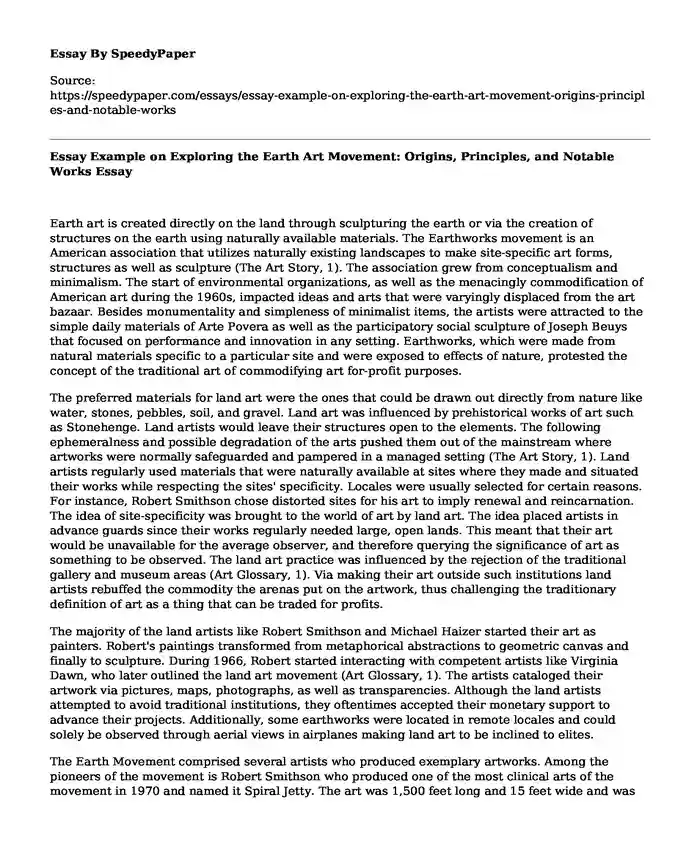
| Essay type: | Definition essays |
| Categories: | Sculpture Art |
| Pages: | 3 |
| Wordcount: | 738 words |
Earth art is created directly on the land through sculpturing the earth or via the creation of structures on the earth using naturally available materials. The Earthworks movement is an American association that utilizes naturally existing landscapes to make site-specific art forms, structures as well as sculpture (The Art Story, 1). The association grew from conceptualism and minimalism. The start of environmental organizations, as well as the menacingly commodification of American art during the 1960s, impacted ideas and arts that were varyingly displaced from the art bazaar. Besides monumentality and simpleness of minimalist items, the artists were attracted to the simple daily materials of Arte Povera as well as the participatory social sculpture of Joseph Beuys that focused on performance and innovation in any setting. Earthworks, which were made from natural materials specific to a particular site and were exposed to effects of nature, protested the concept of the traditional art of commodifying art for-profit purposes.
The preferred materials for land art were the ones that could be drawn out directly from nature like water, stones, pebbles, soil, and gravel. Land art was influenced by prehistorical works of art such as Stonehenge. Land artists would leave their structures open to the elements. The following ephemeralness and possible degradation of the arts pushed them out of the mainstream where artworks were normally safeguarded and pampered in a managed setting (The Art Story, 1). Land artists regularly used materials that were naturally available at sites where they made and situated their works while respecting the sites' specificity. Locales were usually selected for certain reasons. For instance, Robert Smithson chose distorted sites for his art to imply renewal and reincarnation. The idea of site-specificity was brought to the world of art by land art. The idea placed artists in advance guards since their works regularly needed large, open lands. This meant that their art would be unavailable for the average observer, and therefore querying the significance of art as something to be observed. The land art practice was influenced by the rejection of the traditional gallery and museum areas (Art Glossary, 1). Via making their art outside such institutions land artists rebuffed the commodity the arenas put on the artwork, thus challenging the traditionary definition of art as a thing that can be traded for profits.
The majority of the land artists like Robert Smithson and Michael Haizer started their art as painters. Robert's paintings transformed from metaphorical abstractions to geometric canvas and finally to sculpture. During 1966, Robert started interacting with competent artists like Virginia Dawn, who later outlined the land art movement (Art Glossary, 1). The artists cataloged their artwork via pictures, maps, photographs, as well as transparencies. Although the land artists attempted to avoid traditional institutions, they oftentimes accepted their monetary support to advance their projects. Additionally, some earthworks were located in remote locales and could solely be observed through aerial views in airplanes making land art to be inclined to elites.
The Earth Movement comprised several artists who produced exemplary artworks. Among the pioneers of the movement is Robert Smithson who produced one of the most clinical arts of the movement in 1970 and named it Spiral Jetty. The art was 1,500 feet long and 15 feet wide and was created using algae, pebbles, and other natural materials on the northeastern side of Great Salt Lake (The Art Story, 2). Another unique earthwork is created by Michael Heizer in 1969 and referred to as Double Negative. The artwork was funded by Virginia Dawn and involved the cutting of 240,000 tons of volcanic rocks and sandstone from precipices to make two excavations on the edges found East of Mormon Mesa (The Art Story, 3). Richard Long's A Line Made by Walking depicts a work he made by trekking forth and back on a similar pathway in Wiltshire. Other distinctive earthworks include Nancy Holt's Sun Tunnels, Walter de Maria's The Lightning Field, and Agnes Denes' Wheatfield.
The land art movement embraced art produced by natural site-specific materials and resisted traditional artists' concepts of trading art for monetary gains. Earthworks were made using materials found in nature and remained unprotected from the effects of natural occurrences like degradation. Most of the earthwork was located remotely and therefore, limited people who viewed them. Although land artists differed from traditional artists' concept, they still accepted their donations to facilitate their work.
Works Cited
Art Glossary. Land Art. (2020). http://www.visual-arts-cork.com/land-art.htmThe Art Story. Earth Art. (2020). https://m.theartstory.org/movement/earth-art/artworks/
Cite this page
Essay Example on Exploring the Earth Art Movement: Origins, Principles, and Notable Works. (2023, Nov 04). Retrieved from https://speedypaper.com/essays/essay-example-on-exploring-the-earth-art-movement-origins-principles-and-notable-works
Request Removal
If you are the original author of this essay and no longer wish to have it published on the SpeedyPaper website, please click below to request its removal:
- Apartment Design Plan in Our Free Essay Sample
- 12 Angry Men Logical Fallacies Analysis: Free Essay Sample
- Free Essay Example on Women and Grime Music
- Essay Sample on Essence of Music Therapy on Children With ADHD and ASD
- Paper Sample on Harmonizing Emotions: A Jazz Concert at Lincoln Center
- The Icebergs, Fredrick Edwin Church. Essay Example
- Free Essay Sample - The New Orleans-Chicago Jazz Connection
Popular categories




